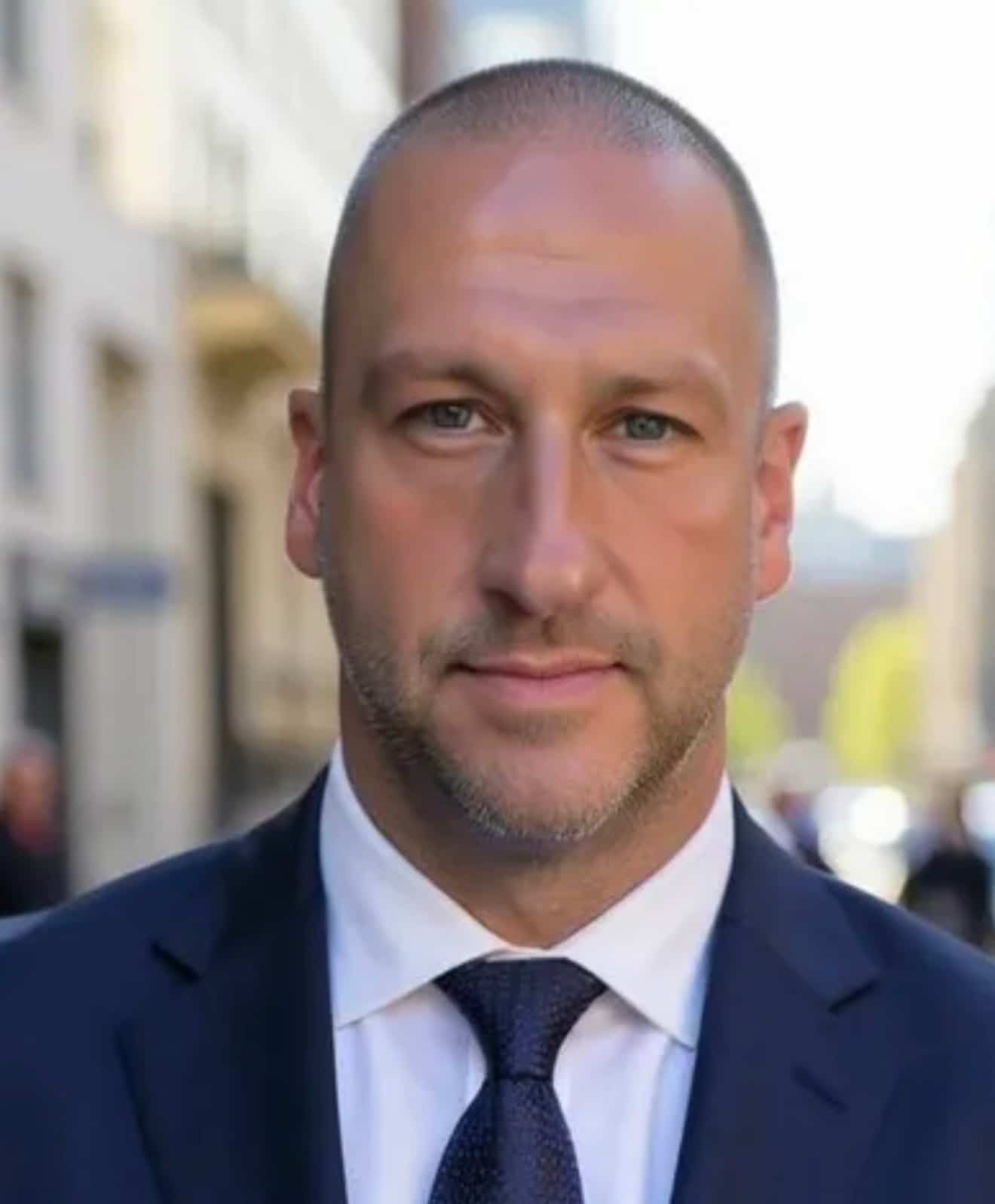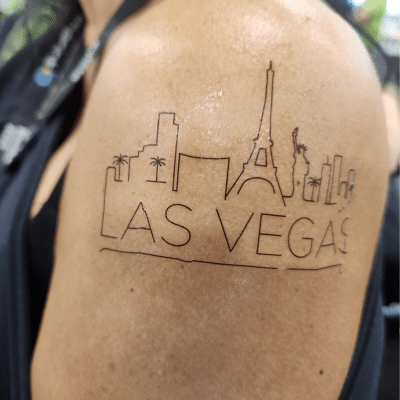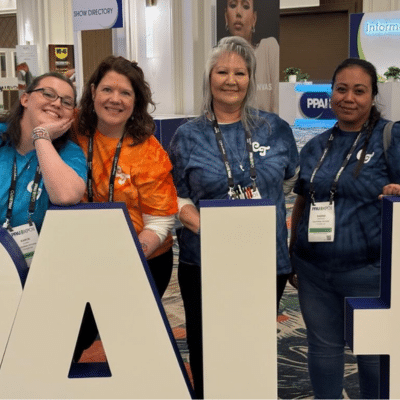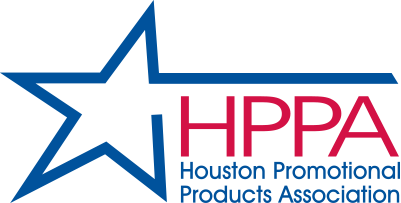Despite being the president of operations at California Tattoos & Promotional Products (PPAI 111028, Silver), Chris Huff doesn’t have an ounce of ink on his body.
It’s not a question of commitment. After all, the man has spent the past 30 years at the same company, weathering leadership transitions, ambitious overhauls and financial turmoil during the pandemic. Throughout all the changes, Huff has remained a steady hand, helping guide the Tucson, Arizona-based supplier to relevancy.
And now, after a recent restructuring and rebrand, he finds himself more excited than ever for the future. Not only is California Tattoos & Promotional Products well-positioned amid the economic uncertainty of the global trade war, but also Huff is surrounded by new colleagues – a blend of familiar and fresh faces to the promotional products industry – who share his optimism about the company’s underrated capabilities and recondite product line.
“There’s a whole bunch of white space out there,” Huff says. “We’re looking to grow the business through education and partnerships. We want to educate distributors on everything we can potentially do for them.”

We want to educate distributors on everything we can potentially do for them.”
Chris Huff
President of Operations, California Tattoos & Promotional Products
What’s In A Name?
You may be wondering why a company called California Tattoos is located in Arizona’s second most populous city.
Well, California Tattoos was acquired by Print Expressions – the commercial printing firm Huff joined in 1995 that had expanded into and revolutionized temporary tattoos.
- Bringing the cumbersome manufacturing process fully in-house, the firm was able to cut costs and production times in half.
- Huff estimates the company currently has the capacity to produce 10 or 12 million temporary tattoos a day.
Print Expressions then embarked on an aggressive M&A strategy with California Tattoos – its biggest competitor at the time – being its final acquisition. Print Expressions then capitalized on the latter’s well-established reputation in promo and assumed that identity.
However, the name has become something of an albatross.
“One of the things we’ve done a pretty abysmal job of over the years is that people don’t really know us for anything other than tattoos,” Huff says. “But we’re a full-blown commercial printing company and can make other things. There’s a significant amount of upside in giving distributors ideas for how to use our products that they can then put in front of their customers.”
That’s where Huff’s new business partner, Jason Kern, president of sales and marketing, comes in.

With tattoos, there’s no one else in the space that does what we do.”
Jason Kern
President of Sales & Marketing, California Tattoos & Promotional Products
With a background in consumer products, Kern comes to California Tattoos with two decades of experience in contributing to the growth of startups and young firms through sales-based strategies. This new role appealed to the UConn graduate because he’s overseen restructuring in other companies.
- Kern was the youngest executive to be responsible for operational control of Altria, a company dedicated to transitioning smokers away from cigarettes.
- He leveraged that experience to a role with NJOY, a startup that focused on e-cigarettes, eventually becoming vice president of sales.
- Since then, he has held VP, president and partner roles at three different emerging companies, most recently as partner of Arête Growth Partners.
Attracted to the creativity of the promo industry, Kern believes California Tattoos is sitting on “untapped opportunity.”
“I went to The PPAI Expo and saw a lot of stuff that’s a different way to look at a widget,” Kern says. “But with tattoos, there’s no one else in the space that does what we do.”
Educating distributors on the different applications of temporary tattoos is Kern’s No. 1 objective. He’s quick to rattle off ideas like making tickets for multi-day events into a tat or leveraging the company’s printing capabilities for designing apparel. Most exciting, he says, is it’s all incremental volume for distributors.
 Booth visitor getting inked at The PPAI Expo 2025.
Booth visitor getting inked at The PPAI Expo 2025.
“What I love about the tattoo space is the expression,” says Kern, whose arms are inked up. “It’s so personal in nature. Depending upon how that’s being used, it can be super playful with kids expressing themselves or finding a creative way to get your brand in the consumer’s hands.”
Of course, once distributors are engaged, it’s up to California Tattoos to follow through. Kern says the company has restructured its customer service department into teams focused on specific accounts so distributors can establish a rapport with their dedicated reps.
“We’ve put a lot of work into building a customer service structure that’s best in class,” Kern says. “We’re focused on being able to deliver within a certain timeframe on a consistent basis and essentially just being able to deliver on our promise.”
Hired Guns
Huff credits Paul Lage, MAS, with drafting California Tattoos’ latest chapter.
The PPAI Hall of Famer was brought on as a consultant in 2021 before briefly serving as interim president and then board member of Tattoo Manufacturing International, the parent company of California Tattoos.
Lage’s marketing savvy approach and personnel changes fueled a rise in both top-line sales and company morale. Huff, who Lage promoted from COO to president, says the latter’s unique pedigree of promo and printing expertise was invaluable.
RELATED: Paul Lage, MAS, Retires After Nearly 40 Years In Promo
“Paul was instrumental in helping me as a mentor, educating our whole team on promo and how we should be doing things differently,” Huff says. “We had been more reactive than proactive because if someone wants tattoos, they’d call us. We weren’t actively promoting ourselves like we should’ve been.”
Lage, who also took Kern under his wing and introduced him to the movers and shakers in promo, is directly responsible for California Tattoos hiring Jill Stirnkorb as vice president of sales and Wendy Flaherty as director of marketing.
- Both worked with Lage, who retired in February, at BIC Graphic, which is now known as PPAI 100 supplier Koozie Group.
With more than three decades of marketing experience, Flaherty has spearheaded California Tattoos’ rebranding, which includes a website redesign scheduled for early June. She describes the company’s new vibe as “beachy dreams meet desert scenes,” alluding to the company’s California coast origin and its stronghold in Arizona.
“California Tattoos honors its legacy while our passionate team brings every design to life with care, creativity and a whole lot of fun,” says Flaherty, who got tattoos with her two daughters when they graduated from college. “We’re all about good vibes, bold designs and bringing a little sunshine and self-expression to every tattoo we make.”

We’re all about good vibes, bold designs and bringing a little sunshine and self-expression to every tattoo we make.”
Wendy Flaherty
Marketing Director, California Tattoos & Promotional Products
A nearly 35-year promo veteran, Stirnkorb was named one of the 2025 Powerhouse Women of Promo. Industry influencer Bill Petrie, who created the list with former podcast partner Kirby Hasseman, commended her “bold move” of jumping from Koozie Group, where she spent her entire career up until December.
Universally regarded as a natural sales pro with the ability to walk into a room and have everyone feel welcomed, Stirnkorb is extremely passionate about the industry, especially the people in it. A former board director of the Promotional Products Association of Florida, she was instrumental in launching its Brandy Awards, which recognize the creative excellence in promo marketing for the region.
Both presidents of California Tattoos recognize her value, as her track record and vast network of connections will help the supplier build relationships with top distributors. “People know she’s not going to be representing something she doesn’t truly believe in,” Huff says.
Intrigued by the excitement consistently generated by the company’s trade show booth, Stirnkorb saw the same potential in California Tattoos as its leadership team does and relishes the chance to boost sales and increase brand awareness.

The message I get across to customers is that we’re more than just a tattoo.”
Jill Stirnkorb
VP of Sales, California Tattoos & Promotional Products
“There’s an opportunity to structure the sales department, building a team to support both new and existing customers, and it’s important to me to be part of that exciting opportunity,” Stirnkorb says. “We’ll be further expanding our sales team soon.”
At every trade show and in all customer interactions, Stirnkorb encourages distributors to include temporary tattoos – which the supplier offers in four inks: classic, glitter, metallic and glow in the dark – in every promotional campaign. With a lasting impression of three to five days, she says, the tattoos turn users into a walking billboard.
- Almost one-third (32%) of American adults have permanent tattoos, according to a 2023 Pew Research Center poll.
- The most cited (69%) reason for getting one is to honor or remember someone or something.
- The increasing popularity of tattoos is projected to push the market to $3.9 billion by 2030, Forbes reported.
Plus, the company offers coasters, fan banners, watercolor paint books and “scratch & win” cards.
“The message I get across to customers is that we’re more than just a tattoo,” says Stirnkorb, who, like Huff, is ink free. “People have been telling me that temporary tattoos are a great way to try out a tattoo if you’re thinking of getting one. No needles needed.”
Made In America
Amid the tariff roller coaster, California Tattoos’ biggest competitive advantage may be that its temporary tattoos are USA-made.
“Everybody is looking for stability right now and there’s very little of it out there,” Huff says. “We can provide a product where the pricing is stable.”
Because the FDA recognizes temporary tattoos as cosmetics, the company invests six figures annually on testing, Huff says, to ensure that it’s compliant with all applicable federal and state government requirements.
- Additionally, all products are tested by an ISO 17025 accredited third-party lab to ensure they meet all applicable U.S., Canadian and European safety standards.
- Business services provider QIMA is one of the testing companies that California Tattoos relies upon, according to Stirnkorb.
“It’s important for people to understand if they’re going to be putting their brand on someone, they’re using the safest, completely approved product that’s out in the marketplace,” Huff says. “We can provide any level of testing.”
 (From left to right:) Karyn Clark, customer success manager; Marci Flaherty, brand manager; Deanna Arias, customer success manager; Sabina Santiago, customer success manager
(From left to right:) Karyn Clark, customer success manager; Marci Flaherty, brand manager; Deanna Arias, customer success manager; Sabina Santiago, customer success manager
Kern adds that distributors seeking cheaper alternatives from overseas should be aware of the risks.
“People think you throw temporary tattoos on your skin like a sticker, but it’s not like that,” he says. “Seepage into your skin can happen. Something that’s produced in China that doesn’t follow the same safety protocols and compliance standards might cost less, but having those standards in place is really important.”
Perhaps because of greater demand for “Made-in-USA” products, the company has seen an uptick in inquiries this year with new account applications rolling in. The efforts of its new leadership team have also played a large role in drumming up interest for the niche supplier.
With the rebranding and restructuring intended to accelerate the momentum, California Tattoos is poised to leave a permanent mark on the promo industry.
As for Huff, he can’t wait for distributors to see what’s up his sleeve.
Written by: John Corrigan
Published with Permission from PPAI
